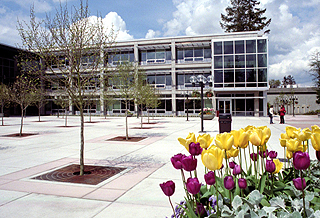
DJC.COM
February 22, 2007
Can buildings be free of fossil fuels by 2030?
CDi Engineers

Jonsson
|
Buildings are big-time polluters, generating half of all carbon dioxide emissions that foul our air. Engineers and architects propose a radical solution — designing buildings that use no fossil fuels of any kind by 2030. Puget Sound hosts a meeting of the minds this spring for making it happen.
Two industry groups team up in Seattle to investigate ideas for creating truly green buildings.
On April 26, the American Institute of Architects Committee on the Environment hosts “What Makes It Green?” The next day, the Cascadia Region Green Building Council holds its “Living Building Challenge.”
Put together, the event, called Living Future 07, offers a unique opportunity for architects and engineers to brainstorm green solutions beyond the confines of their disciplines — and represents the first conference of its kind in the country.
Speaker Edward Mazria kicks off the event on April 25. Mazria is widely considered America’s leading environmental architect. He is executive director of Architecture 2030, an organization focused on protecting the environment. He travels around the world speaking on architecture, design, energy and climate change.

Photo courtesy of CDi Engineers A vertical ground field heat pump system improves energy efficiency at this Bellevue Community College classroom building. Such systems can help meet the goal of cutting fossil fuel use. |
Architecture 2030
Ask a hundred engineers and architects in our region about Architecture 2030, and only a handful will have heard of it. This is shocking, considering the boldness and potential impact of the concept.
Architecture 2030 strives to reduce fossil fuel consumption in all new buildings by 50 percent immediately, increasing this figure in 10 percent increments every five years, until structures emit no greenhouse gases by 2030. Similar goals exist for renovating existing buildings.
“We know these targets are readily achievable and that most buildings can be designed to use only a small amount of energy at little or no additional cost,” states the Architecture 2030 Web site.
“The additional energy a building would then need to maintain comfort and operate equipment can be supplied by renewable sources.”
| Living Future 07 |
|
Seattle Center April 25-27 $50-$460 Register online at http://www.cascadiagbc.org |
Architecture 2030 is sponsored by New Energy Economy, a nonprofit, nonpartisan and independent organization. Its mission is to conduct research and provide information and solutions in the fields of architecture and planning, to address global climate change.
A road map
Jason F. McLennan, CEO of the Cascadia Region Green Building Council, poses similar goals in the “Living Building Challenge,” introduced last year at the U.S. Green Building Council’s annual conference.
“Living Building Challenge” calls for buildings that generate all their own energy with renewable resources, and capture and treat all their own water on site.
In contrast with the LEED point system, the “Living Building Challenge” contains 16 must-have requirements for recognition, addressing site design, energy, building materials, water, indoor environmental quality, and beauty and inspiration. In effect, it provides a specific road map for achieving Architecture 2030, or a metric to push the nation to a zero carbon dioxide footprint as quickly as possible.
“It’s of critical importance that builders are educated and held accountable to meaningful, achievable standards — so that sustainable buildings doesn’t become another undefined slogan,” says the Cascadia Green Building Council in its literature.
“The ‘Living Building Challenge’ is attempting to raise the bar and define a true measure of sustainability in the built environment, at least as far as what is currently possible and given the best knowledge available to date. Projects that achieve this level of performance can claim to be the most sustainable in North America, and not merely less bad.”
Many disciplines contribute
Among many sponsors and supporters of Living Future 07 is the technology, energy and government activities committee of the American Society of Heating, Refrigeration and Air Conditioning Engineers (ASHRAE).
ASHRAE and Cascadia Green Building Council collaborated last year on the EngineeringGreen06 conference, which was intended as a technical training workshop for mechanical engineers. This year’s event is more down-to-earth, and ASHRAE is contributing several technical sessions to the educational portion of the conference.
The engineers who comprise ASHRAE are a critical component of any green building initiative. One can view green building as a complex tapestry, where various disciplines contribute solutions in their area of expertise. These professionals include architects, engineers, contractors, planners and design specialists — all of whom are invited to the Living Future 07 conference.
With a keynote speaker of Ed Mazria’s stature, the conference is certain to spark national and even international attention. And Seattle is once again showcased as a pioneer in sustainable design.
Admittedly, Architecture 2030 and the Living Building Challenge represent a very tall order for designers and engineers. But by raising the bar, they force everyone to start thinking higher.
As Mazria says, “The task we face is daunting. Working separately, we could accomplish something significant in each of our respective spheres. But by working together, we actually have a chance to influence the course of history.”
Leslie Jonsson, PE, LEED AP, CSBA, is a project manager at CDi Engineers in Lynnwood, and is sustainability chair for the Puget Sound chapter of ASHRAE.
Other Stories:
- How much energy are you really saving?
- Green office building goes back to the future
- Let technology play a role in your green building
- Will more cash now mean big savings later?
- Snowboarding can teach us how to be green
- My house is greener than your house
- A platinum LEED rating — how we did it
Copyright ©2009 Seattle Daily Journal and DJC.COM.
Comments? Questions? Contact us.